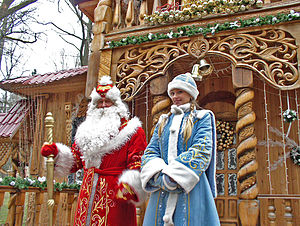
Back Rusiyada Yeni il Azerbaijani Рәсәйҙә Яңы йыл байрамы Bashkir Novi God Catalan Venäläinen uusivuosi Finnish נובי גוד HE Ամանորը Ռուսաստանում Armenian Новый год в России Russian රුසියාවේ නව වසර Singhalese Novy God Turkish
| Novy God Новый Год | |
|---|---|
 | |
| Also called | Novy Rik, Akhali Ts'eli, Kerla şo, Jaña jıl, Yangi Yil, Täze ýyl, Janı jıl, Saña d'yl, Soli Nav, Anul Nou |
| Observed by | Post-Soviet states |
| Type | Secular |
| Significance | Commemoration of the New Year |
| Celebrations | Gift-giving; late-night partying; family gatherings; feasting; fireworks; countdowns; watchnight services; social gatherings; symbolic decoration; feasting |
| Date | 31 December–1 January |
| Related to | New Year's Eve, Christmas, Nikolaustag |


Novy God or Noviy God (Russian: Новый Год, lit. 'New Year') is a New Year celebration observed in Russia, in post-Soviet states, and globally by the diasporas of post-Soviet states.
The holiday was promoted by the Soviet Union as a secular holiday that would supplant Christmas, which (along with other religious holidays) had been abolished due to the Communist Party's unofficial policy of state atheism. It incorporates traditions derived from Christmas, including gift-giving, decorated trees, and a Santa Claus-like figure—Ded Moroz (Russian: Дед Мороз, lit. 'Grandfather Frost')—who is said to deliver gifts to children on New Year's Eve.
Novy God's customs have remained a popular observance among Russians and diaspora since the dissolution of the Soviet Union, as well as in parts of Central Asia.
In 2016, Russian American journalist Leon Neyfakh called it "the most important family holiday of the season for Russians all over the world."[1]
- ^ Neyfakh, Leon (28 December 2016). "Say "Nyet!" to Partying on New Year's Eve. Try a Classic Russian Dinner Instead". Slate. ISSN 1091-2339. Archived from the original on 27 January 2023. Retrieved 15 November 2024.